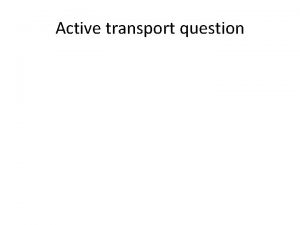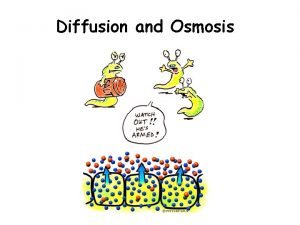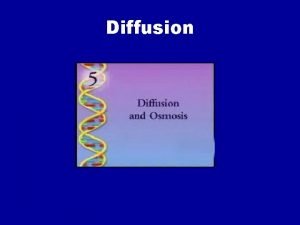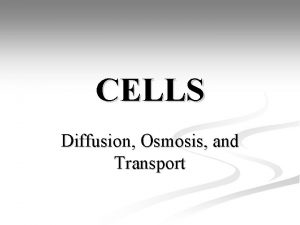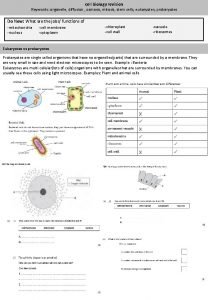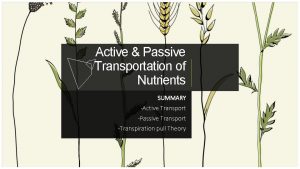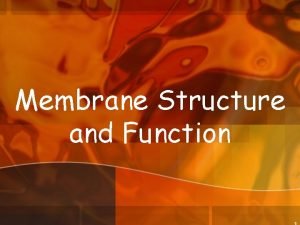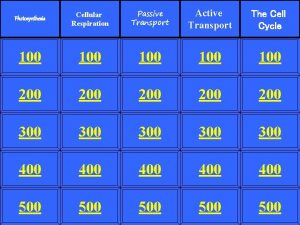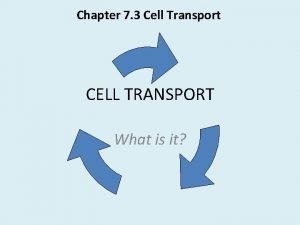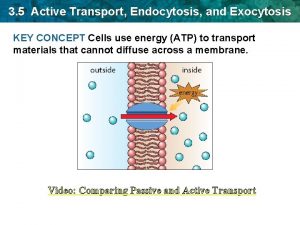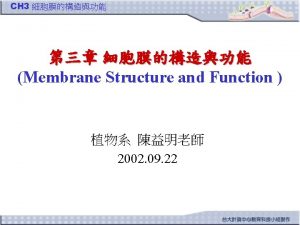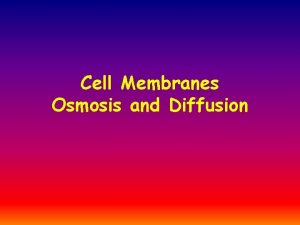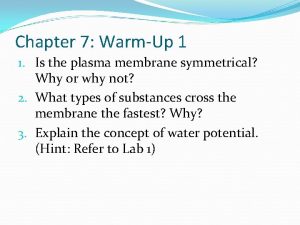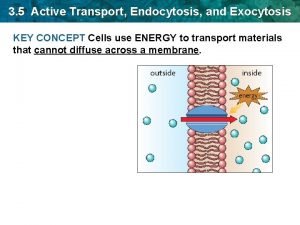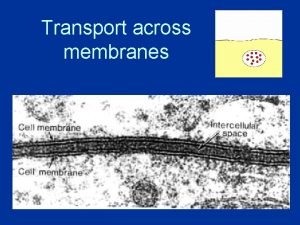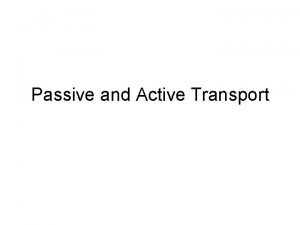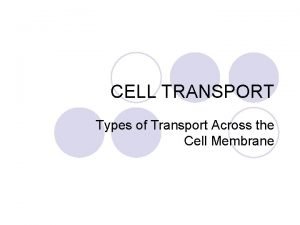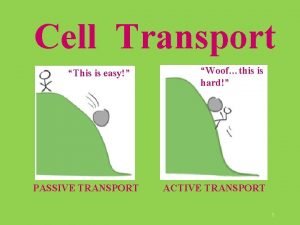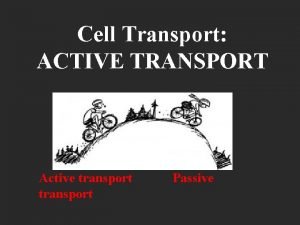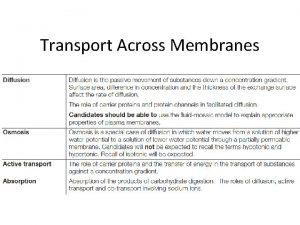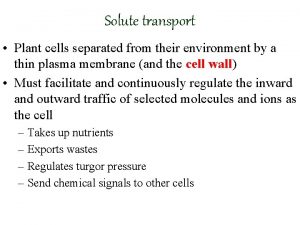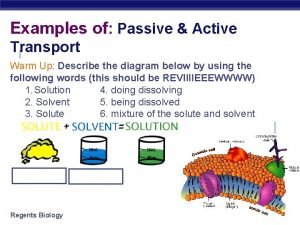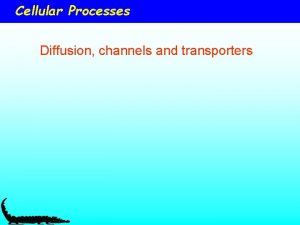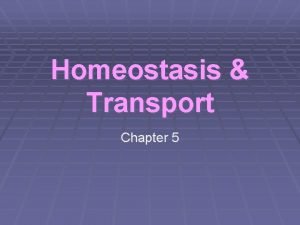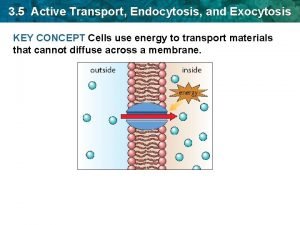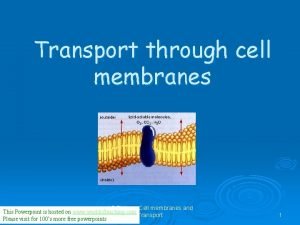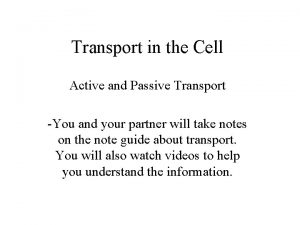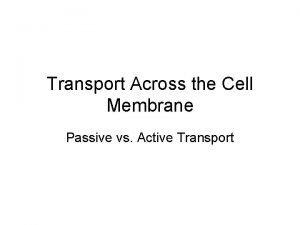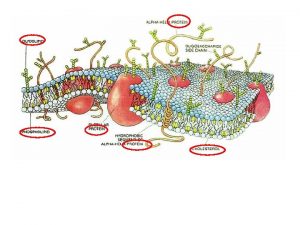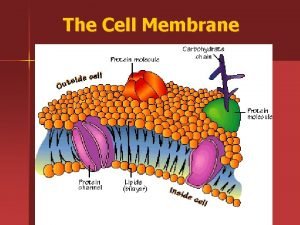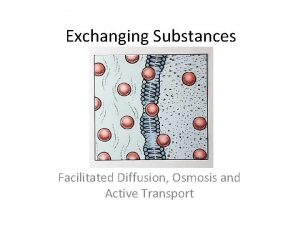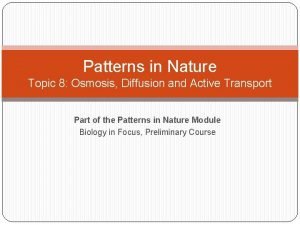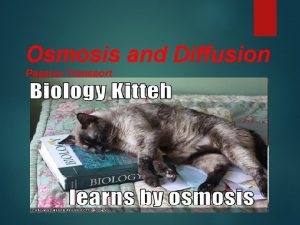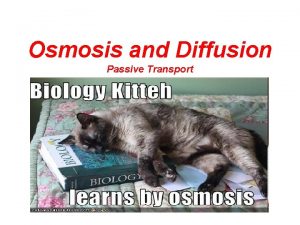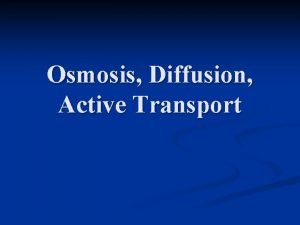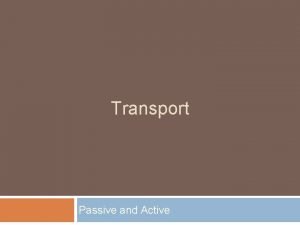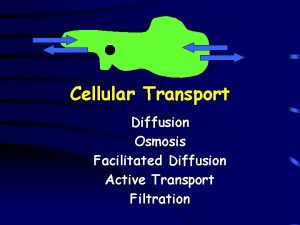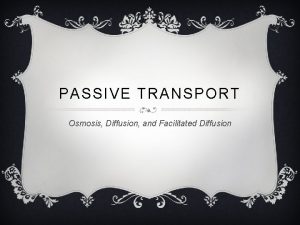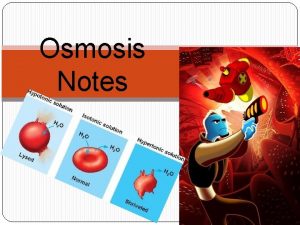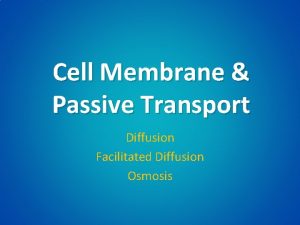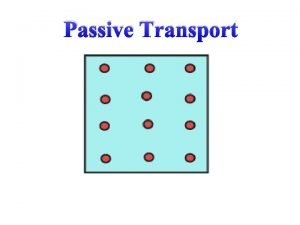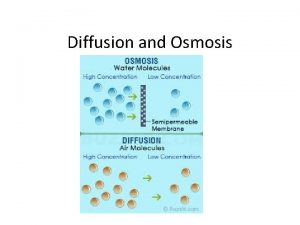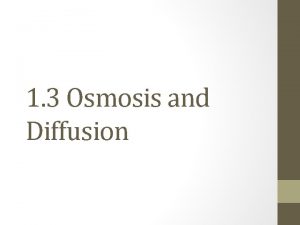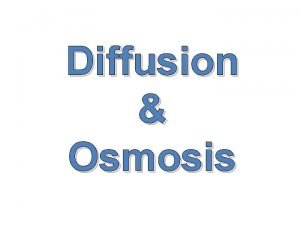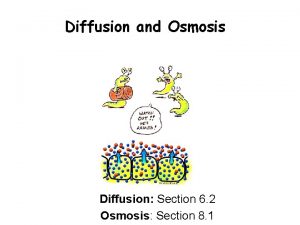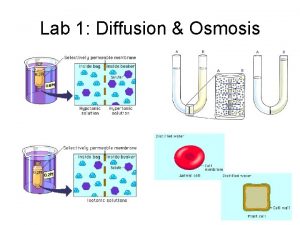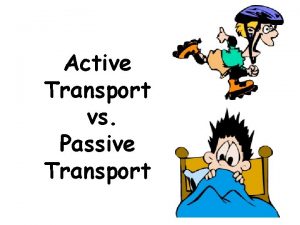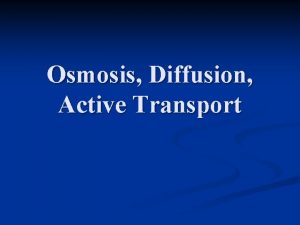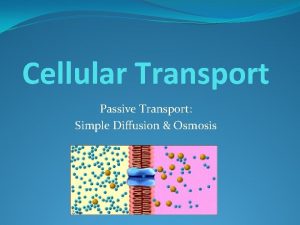Passive Diffusion Osmosis and Active Transport Please copy

























































- Slides: 57

Passive (Diffusion, Osmosis) and Active Transport

Please copy these VOCABULARY WORDS into your notebook! Leave spaces for definitions… ¢ ¢ ¢ ¢ Concentration gradient Semipermeable Passive transport Active transport Diffusion Facilitated diffusion Osmosis ¢ ¢ ¢ ¢ Hypotonic Isotonic Hypertonic Exocytosis Endocytosis Pinocytosis Phagocytosis

Expected performance: ¢You will be able to explain the role of the cell membrane in supporting cell functions!

What is a key property of the Cell Membrane? ¢Selective Permeability!! ¢This property of biological membranes allows some substances to cross more easily than others.

How much energy will it cost the cell to MOVE molecules in or out? depends on HOW it enters the cell! ¢ It do you think does NOT “cost” the cell energy- Passive ¢ Which Transport or Active. Transport?

PASSIVE TRANSPORT does NOT require energy!!! However, the molecules will ALWAYS move from…. A High to a Low concentration!

What is inside and outside of cells? ¢ SOLUTIONS! ¢ THE CONCENTRATION OF THESE SOLUTIONS IS OFTEN WHAT DRIVES THE MOVEMENT OF SUBSTANCES ACROSS A MEMBRANE

What are the 2 parts of a solution? ¢Solute ¢Solvent

Diffusion ¢ Diffusion is the net movement of particles from an area of high concentration to low concentration ¢ The movement of individual particles is random!

Diffusion. Is any energy required for this process?

Diffusion can only occur when there is a gradient – a difference in concentration ¢ This slide demonstrates a gradient of blue ¢ When there is continuous movement but no overall change, a solution is at dynamic equilibrium ¢

Watch this animation! ¢ http: //highered. mcgrawhill. com/sites/0072495855/student_vie w 0/chapter 2/animation__how_diffusio n_works. html ¢ http: //www. indiana. edu/~phys 215/lect ure/lecnotes/diff. html

Onion cell in fresh water

Onion cell in salt water

HOW DO SUBSTANCES MOVE ACROSS A MEMBRANE?

Osmosis ¢ Osmosis is the diffusion of water molecules through a selectively permeable membrane from an area of high water concentration to low water concentration

Isotonic ¢ ¢ A solution with an equal solute concentration compared to inside the cell This cell and solution are said to be in equilibrium 3% Na 97% H 2 O Red Blood Cell solution 3% Na 97% H 2 O

Isotonic ¢ Dynamic Equilibrium: equal amounts of water move in and out of the cell – no net change in movement (H 20 is dark blue)

Isotonic Red Blood Cells in Isotonic Solution

Hypertonic ¢ A solution with greater solute concentration (less water) compared to inside the cell 3% Na. Cl 97% H 2 O Red Blood Cell solution 5% Na. Cl 95% H 2 O

Hypertonic ¢ When concentration of dissolved substances is higher outside the cell than inside (solute is light blue)

Hypertonic ¢ Water will exit the cell causing the cell to shrink

Hypertonic Red Blood Cells in Hypertonic Solution

Hypotonic ¢ A solution with lower solute concentration (more water) compared to inside the cell. 3% Na 97% H 2 O Red Blood Cell solution 1% Na 99% H 2 O

Hypotonic Solution ¢ When concentration of dissolved substances (solute) is lower outside the cell than inside (solute is light blue); Water is HIGHER outside cell.

Hypotonic ¢ Water will enter the cell causing the cell to expand (or explode!) Cell will form an “O”

Hypotonic Red Blood Cells in Hypotonic Solution

Animal Cells ¢ ¢ Animal cells placed into a hypotonic solution will HEMOLYSIS (EXPLODE). Animal cells placed into a hypertonic solution will CRENATE (SHRIVEL). Hemolysis Crenation Red Blood Cells

Plant Cells ¢ ¢ Firmness or tension (vacuole full) that is found in plant cells (cell wall) that are in a hypotonic environment is called TURGID. This process is called TURGOR PRESSURE. Water Cell Water Central Vacuole Water

Plant Cells ¢ When the plasma membrane pulls away from the cell wall (vacuole empty) in a hypertonic environment (loss of water) is called PLASMOLYSIS Water plasma membrane Cell Water

This selectively permeable membrane allows only water across Why does the column of water rise on the right side of this U – tube?

Transport proteins may facilitate diffusion across membranes ¢ Many substances necessary for viability of cell do NOT freely diffuse across the membrane – They require help of specific transport proteins – These proteins assist in facilitated diffusion: type of passive transport that does not require energy – This means movement is always? ? ? Copyright © 2009 Pearson Education, Inc.

Transport proteins may facilitate diffusion across membranes, cont. ¢ Some proteins transport by becoming a hydrophilic tunnel for passage ¢ Other proteins bind passenger, change shape, and release passenger on the other side of membrane ¢ In both of situations, the protein is specific for substrate ¢ It can be sugars, amino acids, ions, or even water Copyright © 2009 Pearson Education, Inc.

Solute molecule Transport protein

Active Transport ¢ The movement of molecules (small or large) across the plasma membrane in which energy (ATP) is required ¢ Examples: 1. 2. 3. Sodium (Na) - Potassium (K) Pump Exocytosis Endocytosis

Sodium-Potassium Pump ¢ The mechanism that uses energy (active transport) released from splitting ATP to transport Sodium (Na+) out of and Potassium (K+) into cells. extracellular fluid intracellular fluid K+ K+ Na+

Protein pumps Some membrane proteins use energy to pump substances in and out of the cell. ¢ Sodium potassium pump animation. ¢

Question: ¢ ¢ ¢ How are large molecules transported into and out of the cell across the plasma membranes? Answer: Exocytosis and Endocytosis

Exocytosis ¢ Cell secretes macromolecules (proteins and other biochemicals) out of (EXIT) cell. ¢ Part of the Endomembrane System: the fusion of transport vesicles with plasma membrane.

Endocytosis Portion of the membrane surrounds or engulfs a large molecule. The membrane pinches off to form a vesicle (vacuole) in the cytoplasm. ¢ Amoeba feeding ¢

Endocytosis ¢ The energy requiring movement of particles (foreign or natural) into (ENTER) the cell. ¢ 3 types of endocytosis: A. Phagocytosis B. Pinocytosis C. Receptor-mediated endocytosis

A. Phagocytosis ¢ ¢ Cell eating: cells engulf particles with pseudopodia and pinches off a food vacuole. Two examples: 1. White Blood Cell 2. Amoeba Lysosome or Vacuole Bacteria White Blood Cell

B. Pinocytosis ¢ Cell drinking: droplets of extracellular fluid are absorbed into the cell by small vesicles ¢ Example: 1. Fungi Food Particles Hyphae

C. Receptor-Mediated Endocytosis ¢ Importing specific macromolecules (hormones) into the cell by the inward budding of vesicles formed from coated pits (receptors). Liver Cell Hormones Receptors

MODELLING A CELL MEMBRANE Materials per Plastic baggies are a lot like cell membranes; they are semipermeable. ¢ Do baggies allow any of the following water, starch, or iodine - to move through them? 1. 2. 3. 4. 5. 6. group: 1 baggy Water Soluble starch solution Iodine solution Beaker Twist ties for baggies

Copy the info below into the next page of your notebook: The relative MOLECULAR sizes of starch, iodine and water are pictured below: Iodine Water Starch

Questions 1. 2. 3. 4. 5. How might the size of the molecule affect its ability to diffuse? Does the molecule size support the results you obtained in your experiment? Explain! List at least five improvements that can be made to the experiment you performed. How is a plastic bag like a cell membrane? Give five reasons! How is a plastic bag different from a cell membrane? Give five reasons!

Homework Quiz- Name the term! A. B. C. D. E. F. Diffusion of water across a selectively permeable membrane Solution with same solute concentration (same water) as cell Continuous movement, but no change in concentration Solution with higher solute concentration (lower water) than cell Random movement of ions & other particles (high-low conc) Solution with lower solute concentration (higher water) than cell

Concentration Problems In each problem below, the membrane is permeable to water only! 1. Which way will water move – into or out of the body cell? (draw an arrow!) 94% water 100% water 2. At dynamic equilibrium, the cell will ____.

3. Which way will water move – into or out of the sphere? (draw an arrow!) 4. Is the solution in the beaker hypotonic, isotonic, or hypertonic compared to the cell? (Circle one!)

5. Which way will water move – into or out of the sphere? (draw an arrow!) 6. What will happen to the shape / size of the sphere? What is the solution outside the cell?

7. Which way will water move – into or out of the body cell? (draw an arrow!) Cell 0. 45 M solute 0. 35 M solute 8. What is the cell’s solute concentration after dynamic equilibrium is reached?

9. Which way will water move – into or out of the body cell? (draw an arrow!) cell 10. What is the cell’s water concentration after dynamic equilibrium is reached?

Do now! http: //highered. mcgrawhill. com/sites/0072495855/student_v iew 0/chapter 2/animation__how_facili tated_diffusion_works. html After watching this animation, write a description of what you are seeing; use (and underline) these words in your description: Cell membrane Energy Facilitated diffusion Protein

Some animations… http: //www. maxanim. com/physiology/Endocyto sis%20 and%20 Exocytosis/Endocytosis%20 and%20 Exocytosis. htm http: //www. sinauer. com/cooper/4 e/animations 1303. html http: //bcs. whfreeman. com/thelifewire/content/c hp 05/0502003. html

Wrap-up! How is the cell membrane structured to ensure efficiency and survival? Explain the role of the cell membrane in supporting at least one cell function.

Now define these terms! ¢ Active transport ¢ Pumps ¢ Exocytosis ¢ Vesicles ¢ Endocytosis l Phagocytosis l Pinocytosis l Receptor- mediated endocytosis
 Primary vs secondary active transport
Primary vs secondary active transport Active transport and passive transport
Active transport and passive transport Primary active transport vs secondary active transport
Primary active transport vs secondary active transport Passive transport vs active transport venn diagram
Passive transport vs active transport venn diagram Passive transport vs active transport venn diagram
Passive transport vs active transport venn diagram Unlike passive transport, active transport requires
Unlike passive transport, active transport requires Osmosis definition
Osmosis definition Facilitated diffusion and active transport
Facilitated diffusion and active transport Facilitated diffusion and active transport
Facilitated diffusion and active transport Active transport low to high
Active transport low to high Diffusion vs active transport
Diffusion vs active transport Diffusion vs active transport
Diffusion vs active transport Diffusion and osmosis
Diffusion and osmosis Passive vs active diffusion
Passive vs active diffusion Facilitated diffusion vs osmosis
Facilitated diffusion vs osmosis Types of diffusion
Types of diffusion Diffusion osmosis
Diffusion osmosis Bioflix activity membrane transport active transport
Bioflix activity membrane transport active transport Selectively permeable definition biology
Selectively permeable definition biology Active and passive transport
Active and passive transport Difference of active and passive transport
Difference of active and passive transport Is photosynthesis active or passive transport
Is photosynthesis active or passive transport Active or passive transport
Active or passive transport Exocytosis active or passive transport
Exocytosis active or passive transport Exocytosis active or passive transport
Exocytosis active or passive transport Active vs passive transport
Active vs passive transport Facilitated diffusion
Facilitated diffusion Expansion diffusion definition
Expansion diffusion definition Passive osmosis
Passive osmosis Does facilitated diffusion require a transport protein
Does facilitated diffusion require a transport protein Bioflix activity membrane transport facilitated diffusion
Bioflix activity membrane transport facilitated diffusion Raymond carver will you please be quiet please
Raymond carver will you please be quiet please Symport antiport uniport
Symport antiport uniport Direct and indirect active transport
Direct and indirect active transport Active transport endocytosis and exocytosis
Active transport endocytosis and exocytosis And or boolean
And or boolean Does exocytosis require energy
Does exocytosis require energy Passive transport
Passive transport Cytolysis
Cytolysis 3 passive transport
3 passive transport Transport cell
Transport cell Exocytosis active or passive
Exocytosis active or passive What is net movement
What is net movement Secondary active transport
Secondary active transport Secondary active transport
Secondary active transport Warm up transport
Warm up transport Is symport secondary active transport
Is symport secondary active transport Active transport animation
Active transport animation Section 5-2 active transport
Section 5-2 active transport Active transport
Active transport Active transport
Active transport Active transport
Active transport Active transport
Active transport Active transport
Active transport Example of active transport in a cell
Example of active transport in a cell Active transport
Active transport Facilitated diffusion
Facilitated diffusion Phagocytosis active transport
Phagocytosis active transport











